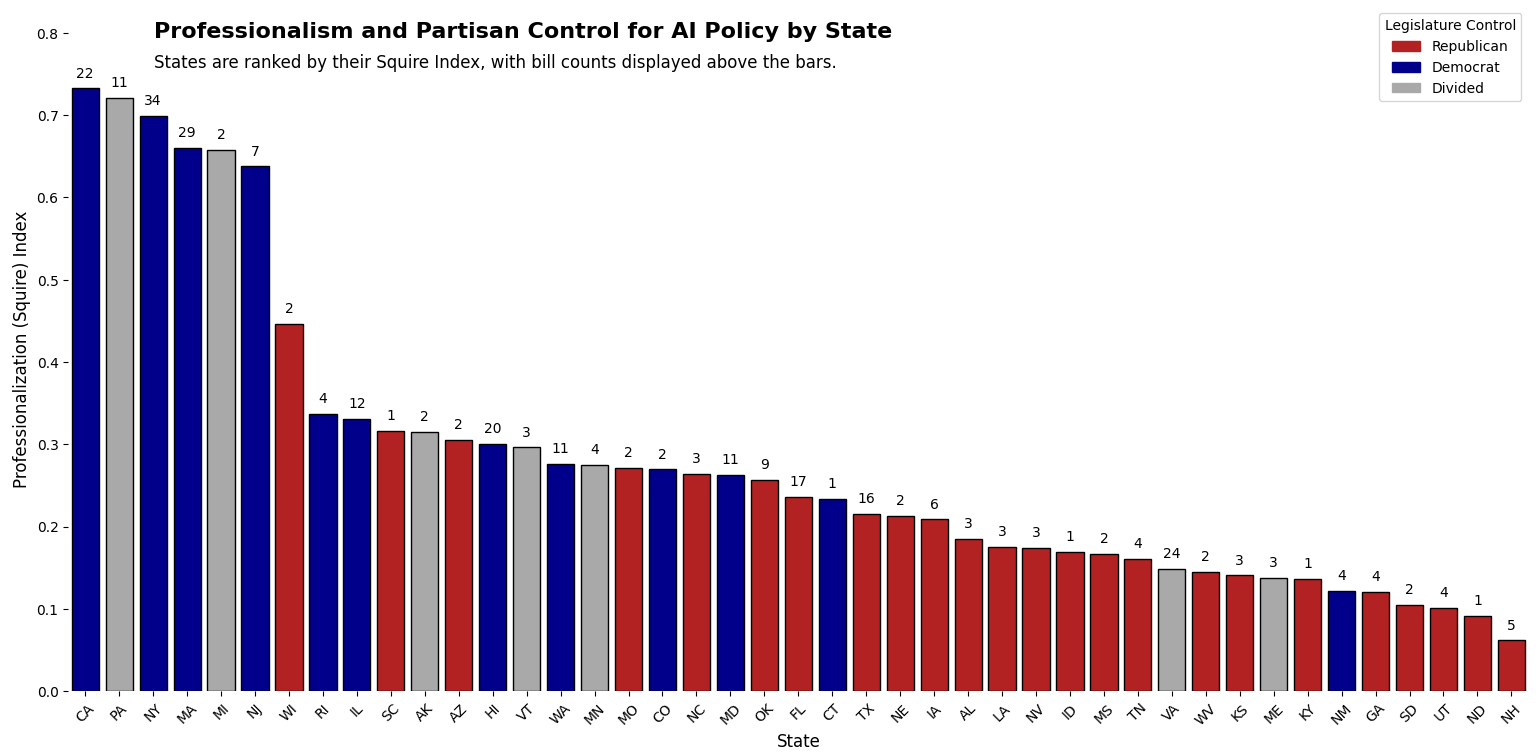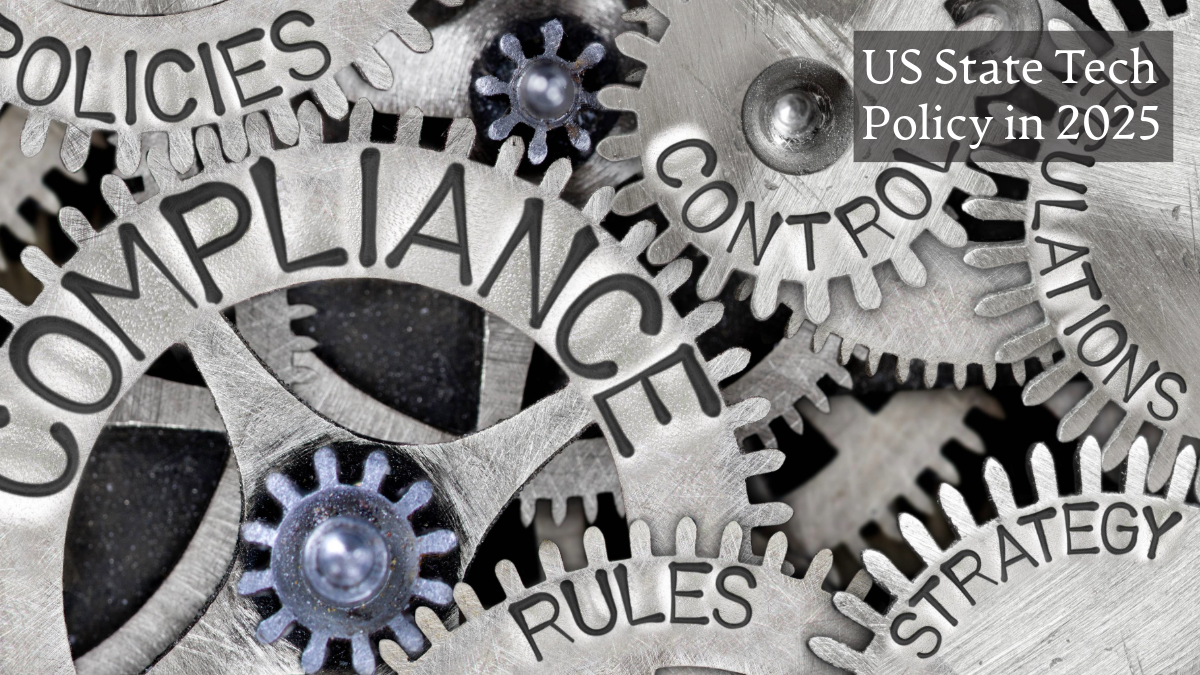The Politics of AI Innovation in the US States
Dr. Stefani Langehennig / Jan 7, 2025In the absence of congressional action, the public turns to state legislatures to address pressing problems, giving them the mandate to act as “laboratories of democracy” – a metaphor coined by Supreme Court Justice Brandeis. State lawmakers have taken the lead on developing policies on complicated issues, including the environment, health care, and, most recently, advancements in AI technology.
My home state, Colorado, has emerged as the first state to create a regulatory framework that protects consumers from “high-risk” AI technology. California’s state legislature recently approved a bill aiming to protect faculty members at community colleges from AI bots poised to take their jobs. Building on Colorado’s AI legislation, the Texas state legislature is considering passing one of the most comprehensive AI bills as we move into 2025. A central feature of the Texas proposal is requiring companies that use AI systems to serve the public or deploy and distribute AI to document their activities to increase transparency and accountability.
The overarching intent for each of these policies is to mitigate legal and ethical violations and improve transparency while at the same time fostering technological innovation. This is an important and seemingly daunting task for states; creating policies related to cutting-edge AI technology requires specialized knowledge and, more importantly, time and resources to develop said policies. While some states are leading the way on AI policy innovation, examining the political factors behind AI policy development is necessary to understand what guidelines are at play in states, what states are lagging in this area, and what the current status of state AI policy means for the future of these policies.
Professionalism and Partisanship
An important aspect of understanding these dynamics is legislative professionalism, or the capacity of a legislature to support career politicians and develop advanced legislation. More professionalized legislatures are likened to Congress, with more staff for lawmakers, more days in session, and better salaries. These factors enable greater oversight of agencies, more bargaining among policymakers, and more attention to detail when creating laws. Research from political scientists supports this, showing that professionalized legislatures are likelier to consider scientifically grounded laws and take on more complex regulations. Thus, states with more professionalized legislatures can leverage their expertise and capacity to craft more advanced legislation, including those addressing cutting-edge technology such as AI.
Another key factor in state lawmaking is the partisan composition of the legislature. While AI concerns cut across party lines, the topic is becoming increasingly partisan. According to the National Conference of State Legislatures, Republicans control more state legislatures (28) compared to Democrats (19), while two states have divided control. This partisan divide has implications for the substance of policy as the two parties tend to approach wedge issues, such as abortion and issues related to social services, along predictable ideological lines. On AI, the approaches between Republicans and Democrats follow traditional political stances from the national parties. For example, Republicans tend to focus on minimal regulation of AI, prioritizing economic growth, while Democrats generally favor proactive regulation with ethical safeguards.
Ranking AI-Related State Policy from the 2023-2024 Legislative Sessions
State legislation is publicly available at various stages of the lawmaking process, making it possible to investigate trends in AI policies with respect to partisanship and legislative professionalism. To examine the evolution of the AI policy landscape in states, legislative data was collected from 43 states during the 2023-2024 state legislative regular sessions in partnership with Sema Technologies and GovHawk. Using a machine learning approach called YAKE, keywords related to AI (e.g., “artificial intelligence,” “AI,” “artificial technology” ) were used to identify legislation related to AI, ranging from introduction to the final stages of passage.
The figure below ranks states by their level of legislative professionalization using a well-known measure called the Squire Index or score. Each bar represents a count of AI-related bills for each state. The bars are also color-coded to reflect partisan control: red for Republican-controlled legislatures, blue for Democratic-controlled legislatures, and gray for divided control (one of the two chambers is controlled by a different party).
We can see what states are the most and least professionalized. The most professionalized states are California, Pennsylvania, New York, and Massachusetts, while South Dakota, Utah, North Dakota, and New Hampshire are the least. There is a clear pattern among the states with partisan composition and professionalism, too: Of the ten most professionalized states, six legislatures are controlled by Democrats, two are controlled by Republicans, and two are divided control. On the other end of the spectrum, ten of the least professionalized states have legislatures that are almost exclusively Republican-controlled (8), with one state legislature divided and one controlled by the Democrats.

A bar graph showing the professionalization and partisan control of AI policy across US states.
Even more interesting is the breakdown of unique AI-related policies making their way through state legislatures, given the various partisan compositions and professionalism scores. One way to think about raw counts of AI-related policy is as a measure of innovation. While a somewhat blunt measure, states with a higher count are presumably first-movers in tackling policy development associated with AI. As the figure shows, some of the most professionalized legislatures controlled by Democrats – including California, New York, and Massachusetts – have a higher volume of AI policy innovations. In comparison, less professionalized legislatures controlled by Republicans, such as North Dakota (42/43 on professionalism), Kentucky (36/43 on professionalism), and Idaho (29/43 on professionalism), have only introduced a single AI-related bill.
While the data suggests a trend of Democratic-controlled, professionalized legislatures driving AI policy innovation, there are some interesting outliers. For example, Democrat-controlled New Jersey ranks 6th in professionalism and 13th in AI policy innovation. Republican-controlled Texas ranks 24th in professionalism and 7th in AI policy innovation. Similarly, divided-control Virginia ranks 33rd on professionalism and 5th in AI policy innovation.
Looking Ahead
What can we expect during the 2024-25 state legislative sessions based on the trends identified above?
- Partisanship will undoubtedly play a role. While partisanship is an accepted feature of US politics, it is associated with less-than-ideal policy outcomes when taken to extremes. As AI policy becomes a focus in upcoming legislative sessions, bipartisan cooperation in the states will be important. Congress’s bipartisan approach in 2024 provides an example for states to follow, though such cooperation is uncertain with Republicans poised to control both chambers moving into the 119th Congress. For states to act as true “laboratories of democracy,” legislators must seek to work across the partisan aisle to create bipartisan, innovative AI policy that addresses the tangible needs of constituents.
- Less professionalized legislatures will need to get creative or reform. The demands of policymaking, particularly on technical issues such as AI, require the legislature to employ people with extensive knowledge about the subject. Crafting robust policies requires access to experts, permanent staff, competitive salaries, and more working days in session–ingredients that are more scarce in less professionalized legislatures. Some academics in less professionalized states are calling for reforms to increase legislative capacity, an important step toward achieving parity in AI policy innovation.
- Governors may dictate the direction of AI policy innovation. Not considered here is the role of governors in AI policymaking, whose power has increased over time. Democratic Governor Gavin Newsom of California signed an executive order with lofty goals of formulating AI reporting standards, training state employees on the technology, and conducting research around its risks. On the flip side, Newsom vetoed AI legislation he felt would unduly burden smaller AI models – a move that some argue will hamper AI safety. At the federal level, President Biden and the executive branch drove much of the AI policy agenda during his administration. The influence of governors on AI policy development will depend in part on a state’s partisan bent and legislative professionalism. In states where governors and lawmakers across legislatures can work together, it could significantly advance AI policy innovation.
This post is part of a series examining US state tech policy issues in the year ahead.
Authors

